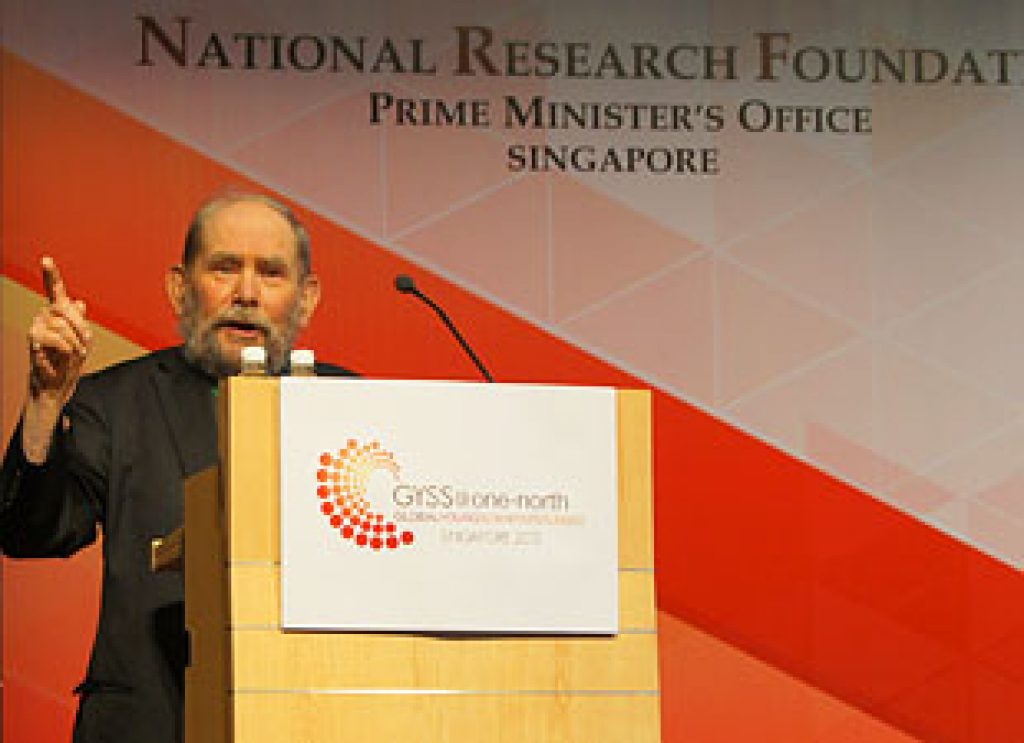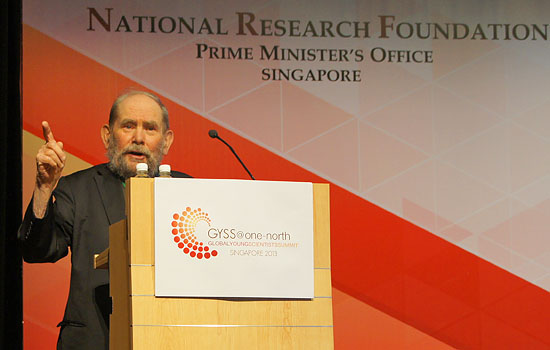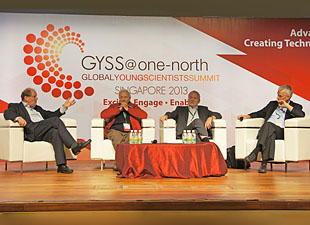
AsianScientist (Jan. 22, 2013) – Nobel Laureate Dr. Sydney Brenner believes that we should all study humans in a dish, a departure from his early studies of the roundworm Caenorhabditis elegans which gave him insights into the genetic basis of programmed cell death.
Speaking at the inaugural Global Young Scientists Summit 2013 (GYSS@one-north) held at Singapore’s one-north academic campus, Dr. Brenner was one of 12 Nobel Laureates and winners of the Millennium Technology Prize, Turing Award, and Fields Medal who were invited to speak about their research to young scientists from around the world.
Describing his prize-winning work that had been done 30 years ago as “not very interesting” and “very old stuff,” he said he wanted to talk instead about his vision of the future of regenerative medicine, and work that he had just started in Singapore.
Sequence of human genome led to much hope, but few drugs
When the Human Genome Project was first successfully completed in 2003, scientists believed that armed with intimate knowledge of the human body blueprint, we would soon understand the basis of disease and discover new cures, said Dr. Brenner.
However, in the past decade these lofty expectations have not quite been met, but not for lack of trying.
“When [the human genome sequence] was announced, everybody thought this would offer new entry into all of human medicine. We’ll have lots of targets for drugs, we’ll have lots of understanding of how mutations affect people, and we’ll enter a new period where we can now make tremendous advances in medicine,” he said.
Many drug targets have been identified and are being tested but Dr. Brenner believes that more targets are no longer necessary; rather, scientists should focus on developing new therapeutic hypotheses.
“I think that hope has not been realized. It is true that there are more targets for drugs, but in fact, what the world needs is not targets, there are plenty of them. What the world needs are therapeutic hypotheses, that says if I take this drug I will change myself, I will be improved, and bad things that I am experiencing will stop.”
“We can’t deduce that from the genome, because we do not have a deeper idea of the function of various parts of it. There are still genes that are present there that we have no idea of what they do,” he said.
While the human genome has evolved gradually over hundreds of thousands of years, our environment has changed far more rapidly, driven by cultural and technological evolution. Dr. Brenner cited the example of how our brains – determined by our genomes – instruct the body to eat as much as possible when food is available.
“Our brains keep on telling us to keep on eating as much as you can, when you can get food, and convert it to fat, because fat is the most efficient way of storing energy which you can use in future,” Dr. Brenner said.
Such an approach was useful historically to ensure the “survival of the fittest” when food was scarce, but in our current abundant world “the famine never comes,” making life all about the “survival of the fattest,” he said.
How do we then better understand the human condition?
To generate therapeutic hypotheses, Dr. Brenner believes scientists need to better understand the molecular mechanisms behind rare genetic diseases.
“What we really have to get down to, is to investigate the human condition at the molecular and cellular level,” Dr. Brenner said, alluding to his newer research into stem cells.
Indeed, induced pluripotent stem cell (iPSC) technology has garnered much attention in the past year. Prof. Shinya Yamanaka, the scientist who first developed the technique, was awarded the 2012 Nobel Prize in Physiology or Medicine together with Prof. John Gurdon, whose work in the 1960s paved the way for Prof. Yamanaka’s discoveries.
In essence, iPSC technology is used to convert an adult differentiated cell, such as a skin cell, into an immature state where the cell becomes capable of making many copies of itself and developing into any cell type in the body, a remarkable ability known as pluripotency. This conversion is stimulated by simply adding four known transcription factors to the cell.
Because the original cell used is taken from a patient’s body, the iPSC and all other differentiated cell types produced e.g. neurons or muscle or heart tissue, can be reintroduced into the patient without fear of immune rejection. For this reason many scientists believe that iPSC technology is the future of regenerative medicine, including Dr. Brenner.
Moreover, he believes that iPSC technology allows scientists to investigate rare human genetic diseases such as Down’s Syndrome without the need for invasive procedures.
In Dr. Brenner’s laboratory at the Agency for Science, Technology and Research (A*STAR) Singapore, cells taken from Down’s patients are being used to create iPSCs. Once generated, these stem cells are stimulated to differentiate into neurons. Scientists in his lab use this approach to study why Down’s patients suffer from learning disabilities and early brain deterioration at around the age of 30 to 40 years, virtually indistinguishable from Alzheimer’s disease in non-Down’s patients aged 70 to 80 years.
By growing and studying neurons in a dish, scientists avoid the need for post-mortem biopsies to obtain neurons from a patient’s brain in order to investigate this degenerative disease, he said.

On-off switches and cell fate
To illustrate the power of transcription factors in controlling the fate of a cell, Dr. Brenner discussed the example of night blindness, a disease caused by either a lack of or gradual loss of function of rod cells in the retina, which detect light entering the eye and send signals to the brain. Photoreceptor cells include rod and cone cells; rod cells function in low light and are capable of detecting as few as six photons of light.
He explained that mutations in a gene known as NRL cause retinal degeneration and loss of rod photoreceptors, resulting in night blindness. When NRL is introduced into mouse retinas that contain only cone photoreceptors, all the cells can be converted into rod photoreceptors. This dramatic change demonstrates that a single transcription factor can transform one cell type directly into another.
Dr. Brenner believes the future of medicine lies in using known transcription factors to control cell fate. More broadly speaking, he says that studying human physiology and disease in a dish will someday lead to a “new revolution in the study of human beings.”
“I think that if we were to try to make 1-D people, they would just be a collection of rods. I think that we could also try to make 2-D people, and they would be a collection of rods and cones. I think that it will be a long time before we can make 3-D people; I think that this is most exciting development in the whole field of biomedical research and I think all the future discoveries – both basic and applied – would be made in this field,” he said.
Among his many contributions to biomedical science, Dr. Brenner is known for discovering messenger RNA (mRNA) and deciphering the mRNA triplet code in the 1960s. For these achievements he was honored with the Albert Lasker Award in 1971, followed by the Nobel Prize in Physiology or Medicine in 2002.
——
Copyright: Asian Scientist Magazine. Photos: Asian Scientist Magazine.
Disclaimer: This article does not necessarily reflect the views of AsianScientist or its staff.












